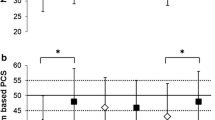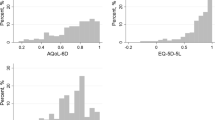Abstract
Objectives: There have been no studies of generic health-related quality of life (HR-QOL) measured prospectively, in patients referred for bone mass measurement. The aim of this study was to examine the relationship between HR-QOL, measured before DXA scanning was undertaken, and bone mineral density (BMD). Comparison of HR-QOL with the age- and sex-matched general population was also made. Design: HR-QOL questionnaires were completed by patients who were being entered into a randomized, prospective, parallel group trial to assess the impact of direct access DXA scanning (DADS) versus referral to a hospital consultant, upon clinical decision making by general practitioners (GPs) (Dhillon et al., Osteoporos Int 14:326–333, 2003). HR-QOL questionnaires were completed prior to both randomization and DXA scanning. Participants: 325 patients from18 representative general practices of a total of 77 in the city of Edinburgh. Patients had been referred by their GPs who had access to national guidelines on the identification of patients at high risk of osteoporosis. Outcome measures: Generic HR-QOL was measured using Euroqol (EQ5D). This provides a profile of self-reported problems in five dimensions (EQ5Dprofile), health utility (EQ5Dutility), and a visual analogue global self-rated health assessment (EQ5Dvas). Results: Odds ratios (ORs) for any self-reported problems on EQ5Dprofile were higher in patients with osteoporosis than those without, and compared with the general population. Age-adjusted mean (SD) EQ5Dutility was significantly lower in patients with osteoporosis than in those without (0.65 [0.28] vs 0.76 [0.27]; p<0.01), but the difference lessened with advancing age. Age-adjusted mean (SD) EQ5Dvas was significantly reduced in patients with compared with no osteoporosis (68 [20] vs 76 [16]; p<0.01). There were no such differences in patients with a history of prior fracture compared with those without a history of prior fracture. Conclusions: Female patients with osteoporosis have reduced generic HR-QOL compared with the age-matched female general population, irrespective of a history of prior fracture. The causal relationship between osteoporosis and HR-QOL, if any, is unclear. Further studies are needed to define this relationship and to determine whether treatment of osteoporosis has a beneficial effect on HR-QOL independent of fracture risk.
Similar content being viewed by others
References
Ionnidis G, Gordon M, Adachi JD (2001) Quality of life in osteoporosis. Nurs Clin North Am 36(3):481–489
Adachi JD, Ionnidis G, Berger C et al (2001) The influence of osteoporotic fractures on health-related quality of life in community-dwelling men and women across Canada. Osteoporos Int 12:903–908
Lips P, Cooper C, Agnusdei B et al (1997) Quality of life as outcome in the treatment of osteoporosis: the development of a questionnaire for quality of life by the European Foundation for Osteoporosis. Osteoporos Int 7:36–38
Oleksik A, Lips P, Dawson A et al (2000) Health related quality of life in postmenopausal women with low BMD with or without prevalent vertebral fractures. J Bone Miner Res 15:1384–1392
Lydick E, Zimmerman SI, Yawn B, Love B, Kleerekoper M, Ross P et al (1997) Development and validation of a discriminative quality of life questionnaire for osteoporosis (the OPTQoL). J Bone Miner Res 12:456–463
Gold DT (1996) The clinical impact of vertebral fractures: quality of life in women with osteoporosis. Bone 18[Suppl]:185S–189S
Chandler JM, Martin AR, Girman C, Ross PD, Love-McClung B, Lydick E, Yawn BP (1998) Reliability of an osteoporosis-targeted quality of life survey instrument for use in the community: OPTQoL. Osteoporos Int 8(2):127–135
Roberto KA (1997) Stress and adaptation patterns in older osteoporotic women. Women’s Health 14:105–119
Dhillon V, Creiger J, Hannan J, Hurst N, Nuki G (2003) The effect of DXA scanning on clinical decision making by general practitioners: a randomised, prospective trial of direct access versus referral to a hospital consultant. Osteoporos Int 14(4):326–333
National Osteoporosis Society, Scientific Advisory Committee (1995) Local provision for osteoporosis. NOS, Bath
Royal College of Physicians of London (1999) Osteoporosis: guidelines for prevention and treatment. Royal College of Physicians of London, London
National Osteoporosis Society (2000) Reducing fractures and osteoporosis in Scotland. NOS, Bath
Euroqol Group (1990) Euroqol—a new facility for the measurement of health-related quality of life. Health Policy 16:199–208
Dolan P, Gudex C, Kind P, Williams A (1995) A social tariff for EuroQol: results from a UK general population survey. Discussion Paper, No. 138. Centre for Health Economics, University of York, York
Kind P, Hardman G, Macran S (1999) UK population norms for EQ5D. Discussion Paper, No. 172. Centre for Health Economics, University of York, York
Prescott-Clarke P, Primatesta P et al (eds) (1996) Health survey for England 1996. TSO, London. ISBN 0 11 322091X
World Health Organization Study Group (1994) Assessment of fracture risk and its application to screening for post-menopausal osteoporosis. Technical Report Series, No. 843, Section 3.2.3. WHO, Geneva
Carstairs V, Morris R (1991) Deprivation and health in Scotland. Aberdeen University Press, Aberdeen
Hurst N, Kind P, Ruta D, Hunter M, Stubbings A (1997) Measuring health-related quality of life in rheumatoid arthritis: validity, responsiveness and reliability of Euroqol (EQ-5D). Br J Rheumatol 36:551–559
Cockerill W, Lunt M, Silman AJ et al (2004) Health-related quality of life and radiographic vertebral fracture. Osteoporos Int 15:113–119
Kind P, Dolan P, Gudex C, Williams A (1998) Variations in population health status: results from a United Kingdom national questionnaire survey. BMJ 316:736–741
Martin AR, Sornay-Rendu E, Chandler JM, Duboeuf F, Girman CJ, Delmas PD (2002) The impact of osteoporosis on quality-of-life: the OFELY cohort. Bone 31(1):32–36
Cizza G, Ravn P, Chrousos GP, Gold PW (2001) Depression: a major, unrecognized risk factor for osteoporosis? Trends Endocrinol Metabol 12(5):198–203
Robbins, JA, Hirsch, C, Whitmer, R et al (2001) The association of bone mineral density and depression in an elderly population. J Am Geriatr Soc 49:732–736
Reginster JY (1999) Depressive vulnerability is not an independent risk factor for osteoporosis in postmenopausal women. Maturitas 33:133–137
Acknowledgements
Conflict of interest: None. Contributors: Ms J. Creiger, study co-ordinator for the DADS trial [9]. We thank all GPs and patients who participated in the original DADS trial, Ms C. Millar and Mr C. Sidey for acquiring and analyzing the DXA scans, and Mr C.M. Ferrington for writing the Access databasefor that trial [9]. Funding: Lothian University NHS Endowment Fund, and Merck, Sharp, and Dohme—for the original DADS trial [9]. None for this study.
Author information
Authors and Affiliations
Corresponding author
Rights and permissions
About this article
Cite this article
Dhillon, V., Hurst, N., Hannan, J. et al. Association of low general health status, measured prospectively by Euroqol EQ5D, with osteoporosis, independent of a history of prior fracture. Osteoporos Int 16, 483–489 (2005). https://doi.org/10.1007/s00198-004-1705-3
Received:
Accepted:
Published:
Issue Date:
DOI: https://doi.org/10.1007/s00198-004-1705-3




